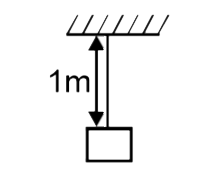A string of length 0.4m and mass 10−2kg is clamped at one end . The tension in the string is 1.6N. The identical wave pulses are generated at the free end after regular interval of time , Δt . The minimum value of Δt , so that a constructive interference takes place between successive pulses is Solution in Gujrati
0.05 s
0.10 s
0.20 s
0.40 s
The correct Answer is:B
Mass per unit length of the string
m=10−20.4=2.5×10−2kg/m
∴ Velocity of wave in the string
v=√Tm=√1.62.5×10−3⇒v=8m/s
For constructive interference between successive pulses
Δtmin=2lv=(2)(0.4)8=0.10s
After two reflections, the wave pulse is in same phase as it was produced, since in one reflection its phase changes by π, and if at this moment next identical pulse is produced, then constructive interference will be obtained.
Topper's Solved these Questions
Similar Questions
Tube A has both ends open while tube B has one closed, otherwise they are identical. The ratio of fundamental frequency of tube AandB is
View SolutionAt absolute zero temperature Si acts as ……..
View SolutionA standing wave is produced on a string on a string clamped at one end and free at the other. The length of the string
View SolutionTwo long strings A and B, each having linear mass density 1.2×10−2kgm−1, are stretched by different tensions 4.8 N and 7.5 N respectively and are kept parallel to each other with their left ends at x = 0. Wave pulses are produced on the strings at the left ends at t = 0 on string A and at t = 20 ms on string B. When and where will the pulse on B overtake that on A ?
View SolutionA string of length 0.4 m and mass 10^(-2)kg is tightly clamped at its ends. The tension in the dtring is 1.6 N . Idential wave pulse are produced at one end at equal intervals of time, Deltat . The minimum value of Deltat which allows constructive inetrference successive pulse is
View SolutionA string of length 0.4 m and mass 10^(-2) kg is clamped at one end . The tension in the string is 1.6 N . The identical wave pulses are generated at the free end after regular interval of time , Delta t . The minimum value of Delta t , so that a constructive interference takes place between successive pulses is
View Solution(i) The equation of wave in a string fixed at both end is y=2sinπtcosπx. Find the phase difference between oscillations of two points located at x=0.4m and x=0.6m.
(ii) A string having length L is under tension with both the ends free to move. Standing wave is set in the string and the shape of the string at time t=0 is as shown in the figure. Both ends are at extreme. The string is back in the same shape after regular intervals of time equal to T and the maximum displacement of the free ends at any instant is A. Write the equation of the standing wave.

View Solutionएक डोरी जिसकी लम्बाई 0.4 मीटर तथा द्रव्यमान 10−2 किग्रा है, दोनों सिरों पर तनी हुई कसी है। डोरी में तनाव 1.6 न्यूटन है। डोरी के एक सिरे पर समान समयान्तरालो Δt पर एक-सी तरंग-स्पन्दे उत्पन्न की जाती है। Δt का न्यूनतम मान जो दोनों स्पन्दो के बीच संपोषी व्यतिकरण उत्पन्न करता है :
View SolutionA string of mass 0.250 kg is under a tension of 2 N. The length of the stretched string is 2 m. A transverse wave disturbance starts at one end of the string . How long will the disturbance take to reach the other end ?
View SolutionA block of mass 1 kg is hanging vertically from a string of length 1 m and Mass/length =0.001 kg/m. A small pulse is generated at its lower end. The Pulse reaches the top end in approximately.

View SolutionA string of length 0.4 m and mass 10^(-2) kg is tightly clamped at its ends. The tension in the string is 1.6 N. Identical wave pulses are produced at one end in equal intervals of times Delta t. the minimum value of Delta t, which allows constructive interference between successive pulses , is :
View SolutionA string of length 0.4 m and mass 10^(-2) kg is rigidly clamped at its ends. The tension in the string is 1.6 N. Identical wave pulses are produced at one end at equal intervals of time Delta t . The minimum value of Delta t which allows constructive interference between successive pulses is :
View SolutionA string of length 0.4 m and mass 10−2 kg is clamped at its ends. The tension in the string is 1.6 N. When a pulse travels along the string the shape of the string is found to be the same at times t and t+△t. The value △t is
View SolutionA string of length 0.4m and mass 10−2 kg is tightly clamped at its ends. The tension in the string is 1.6N. Identical wave pulses are produced at one end al equal intervals of time Δt . The minimum value of Δt , which allows constructive interference between successive pulses is
View SolutionA standing wave is produced on a string on a string clamped at one end and free at the other. The length of the string
View SolutionA string of length 0.4m and mass 10^(-2) kg is tightly clamped at its ends. The tension in the string is 1.6N..Identical wave pulses are produced at one. end al equal intervals of time Deltat - The minimum value of Deltat , which allows constructive interference If between successive pulses is
View Solution
